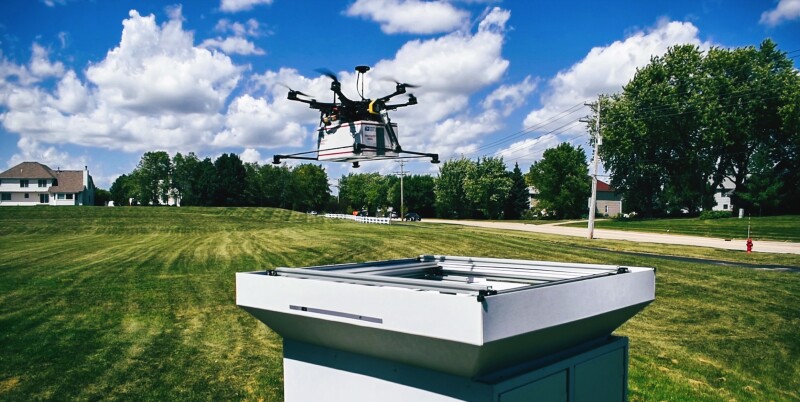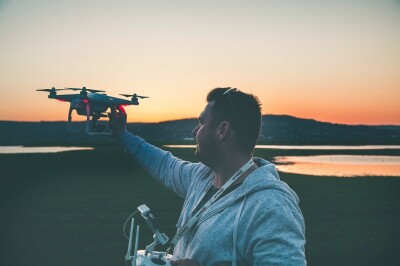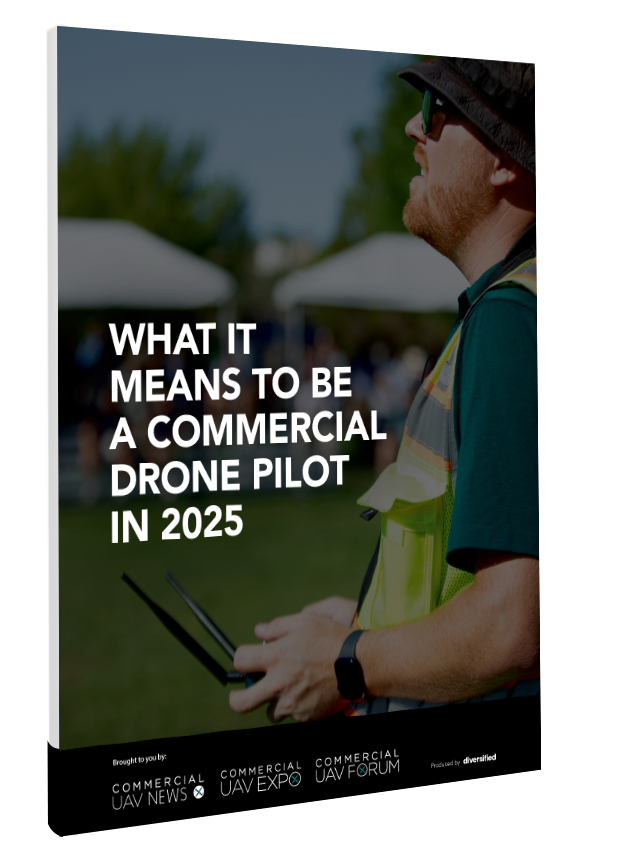Earlier this year, Commercial UAV News Editorial Director Jeremiah Karpowicz wrote an article stating that 2023 would be a “pivotal” year in drone delivery. Despite ongoing regulatory and economic challenges and some well-documented setbacks experienced by leading companies, he said that the sector was poised to grow for a number of reasons, including strong consumer demand.
Indeed, in many parts of the world, individual customers and businesses have increasingly called on drones to deliver a wide range of packages and products. Increasingly, these consumers are looking to uncrewed vehicles to provide vaccines and medical supplies, food, and even heavy equipment and industrial materials.
An August 2022 article in Retail Consumer Experience shows the favorable way many consumers view deliveries by UAV. The article cites a July 2022 Auterion survey of 1,000 consumers finding that 58% were in favor drone deliveries generally, 64% believed that “drones will be an option for home delivery in the very near future,” and “47% said they would make a purchase from a specific retailer due to the option of a drone delivery program.” The article also reported on a related study revealing that almost 50% of consumers stated that they would pay more money for a delivery if they could get items in an hour.
Many companies have heard this message and are responding with expanded services, new technologies, and innovative delivery networks and systems. At present, according to Drone Industry Insights, Zipline, Wing, Matternet, Swoop Aero, and Manna are the top companies in the drone delivery sector. However, many other companies are moving ahead as they work to increase service areas, streamline operations, and reduce costs.
Significantly, one of those companies is Amazon. The retail giant has recently signaled its intention to expand its Prime Air drone delivery system in Italy and the UK in the coming year, while adding an additional US city to the two communities it currently serves. Central to this expansion is the deployment of the MK30 drone. Billed as a “quieter, smaller, and lighter” drone than previous models, the MK30, the company announced, “can fly twice as far as previous Prime Air drone models,” allowing for an expansion of the company’s fulfillment networks. Also, the MK30 features a delivery system in which “packages are held inside drones during transit to protect their contents,” and it comes with sense and avoid technology, enabling the vehicle to identify and evade obstacles encountered in the delivery area.
Because of news like this, the sector is set to accelerate at a rapid rate. A study commissioned by NASA asserted that there may be as many as 500 million drone delivery flights each year by 2030. Moreover, an October 2023 report by Market.us on the global drone package industry stated that “market revenue reached USD 1,332.0 billion in 2022” and estimated that sales in the sector “are estimated to total USD 1,964.7 billion in 2023.” Over the next ten years, the report said, “the market is poised to grow at 47.5% CAGR,” and “(R)evenue will likely reach USD 64,926.9 billion by 2032.”
Here’s a look at some recent developments in the drone delivery sector.
Continued Growth in Drone-Based Medical Deliveries
One of the most successful use cases for UAVs has been medical deliveries, and the use of uncrewed systems to bring critical supplies to individuals and healthcare facilities continues to grow.
- The Cleveland Clinic announced plans to use drones to deliver certain medications to patients’ homes in 2025. In time, the healthcare system hopes to expand the program to include “delivery of lab samples, prescription meals, medical and surgical supplies, and items for hospital-at-home services.”
- Amazon revealed its intention to begin a prescription medication delivery service in College Station, Texas, and then expand the program to other cities. As part of the plan, Amazon aims to drop medications at consumers’ homes within one hour of placing the order with no additional cost.
- In the UK, the Civil Aviation Authority has approved six trial projects to further BVLOS drone flights for medical drone deliveries. Trials in controlled environments will test new technologies to see how uncrewed vehicles can be integrated into the airspace.
Focus on Heavy Lift Drones
Delivering heavy equipment and industrial supplies by conventional air and ground methods can be cost-prohibitive and even dangerous, so many companies are turning to heavy lift and cargo drones. Larger sized uncrewed systems are also being adapted for use in inspections, public safety, and other operations.
- This past spring, Drone Delivery Canada (DDC) signed a contract with the Canadian Government’s Innovative Solutions Canada program to work with Transport Canada to test DDC’s Condor, a heavy-lift remote piloted aircraft. The Condor features a multi-package payload compartment that can carry approximately 20 cubic feet of cargo. DCC is looking to adapt the vehicle for mining, oil and gas inspections, and emergency preparedness uses.
- The Danish company Ørsted has been conducting trials using a giant robotic drone to supply cargo to offshore wind turbines. The 58kg drones have a wingspan of 2.6 meters and can transport cargo up to 68kg.
- A2Z Drone Delivery, Inc. launched its second generation RDST integrated cargo drone. The RDST Longtail features the company’s factory integrated RDS2 drone winch enabling payloads to be deposited safely from altitude where spinning rotors are kept far from people and property.
- ParaZero Drone Safety Solutions partnered with Parallel Flight Technologies to integrate customized parachute safety systems with a heavy-lift, long-endurance UAV. Designed for Drone Delivery, BVLOS flights, and operations over people, ParaZero’s parachute safety system, SafeAir, helps customers achieve advanced use case approvals.
Drones for Postal Deliveries
In many countries, postal services are turning to drones to deliver mail to residents. The approach is especially useful in serving those who live in remote, hard-to-reach communities, but the technology is also being adapted to facilitate deliveries in congested areas.
- In 2022, as part of the UK Royal Mail's expansion of drone delivery mail routes, the service announced a partnership with Windracers Group, a manufacturer of twin-engine fixed-wing UAVs, to establish more than 50 new postal drone routes over the next three years. Royal Mail's plan will facilitate faster and more convenient services for customers in remote communities, such as island communities across the Isles of Scilly, Shetland Islands, Orkney Islands, and the Hebrides.
- Dronamics and Hellenic Post (ELTA) signed an agreement for first postal cargo drone deliveries in Greece and begin commercial operations early in 2024. In time, the company hopes to provide same-day service between Athens and areas in the north of the country, as well as islands in the south.
- In Asia, Japan Post made its first trial parcel drop earlier this year, delivering mail to a private home following the company’s first flight over a populated area. Japan Post officials say that they hope to launch of regular aerial services to households around the country as an alternative to delivering mail by ground-based vehicles.
New Systems and Services
Advancing the drone delivery sector even further will require new approaches to ordering systems, package pickup options, flight planning, and more.
- German researchers are collaborating with local authorities on a project to test the viability of using uncrewed systems to transport goods in rural regions and promote urbanization. They envision a “holistic approach” in which a regional logistic hub is placed in the main part of the town, and people can go there to retrieve goods delivered by UAV. The local distribution centers would also offer social services for residents, and individuals would have the opportunities to come to these hubs and participate in delivering goods to other residents, specifically those who are elderly or disabled.
- In Korea, Skyports Drone Services partnered with RigiTech to launch an app for requesting drone deliveries. Available in Korea’s Yeosu region, the app increases access to supplies such as food and medicine for people living on the area’s 45 islands. The app could also give island residents an opportunity to sell their products on the mainland.
- Introduced this year, Trimble’s PX-1 RTX™ solution enables accurate and robust positioning and heading for commercial drone delivery applications. The system allows drone integration companies to add precise positioning capabilities so operators can more efficiently plan and execute takeoff, navigation, and landing tasks associated with drone delivery operations.















Comments